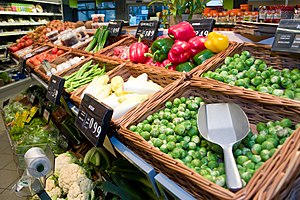Last week we talked about ongoing shifts in the beverage industry, and this week I would like to follow up with a discussion of the associated category of trends in food products and consumption.
Just as with beverages, consumers want healthier products for themselves and their families. They are looking to manufacturers to provide better-for-you ingredients, and are getting smarter about knowing the science behind what is showing up on retail shelves. Many new products and emerging food categories are being introduced having more protein, less preservatives, and more vegetables and are being offered in increasingly unprocessed forms.
Consumers today are spending more time in the interesting peripheral areas of the modern grocery store, like the bakery, the deli, or the coffee/cafe area. They are being encouraged by retailers to do so. A recent National Eating Trends Report from the market research company NPD Group, shows consumers are purchasing more poultry and fish, fresh fruit, nuts and seeds, cheeses, soy milk, Greek yogurt, and coconut water.
Many consumers today are also becoming more conservative in snack habits, with a little less than half of shoppers saying they are cutting back on snack purchases, and about a quarter saying they’ve eliminated snack purchases altogether.
Manufacturers are using their brands and the latest technology to reach out and “feed” these new consumer-purchasing choices. With new food products, novel marketing ideas, and a higher bar set on convenient food packaging, you’re going to start seeing a transformation of products on grocery store shelves that will continue to evolve.
Consumers still look at food as a vehicle for nutrition, but on the flip side some people are also beginning to look at food as a channel for the delivery of harmful allergens and unnecessary constituents like excess preservatives, salt, and fats.
Superficial awareness is no longer enough though, so manufacturers, retailers, health advocates and even insurance companies are investing in education to help consumers understand the reality today. It’s no surprise that consumers will be more likely to purchase the products that manufacturers have make easy for them to understand what it is and why it is good for them and their families.
Smaller, niche brands continue to gain momentum in the marketplace. Specialty foods come at a premium price, but consumers see these brands as providing them with healthier exotic and ethnic flavored foods that help meet their cravings and desires.
Some consumer habits will be hard to change though. Another NPD survey just released this week shows that 50 percent of adults purchase candy as the top snack item for their family over the holidays, followed closely by chips. The purchase of fresh fruit comes in third.
Filling those stockings with chocolate is a holiday tradition that may happily be around for quite awhile. However I suspect the January crowd at the local fitness center will too.

